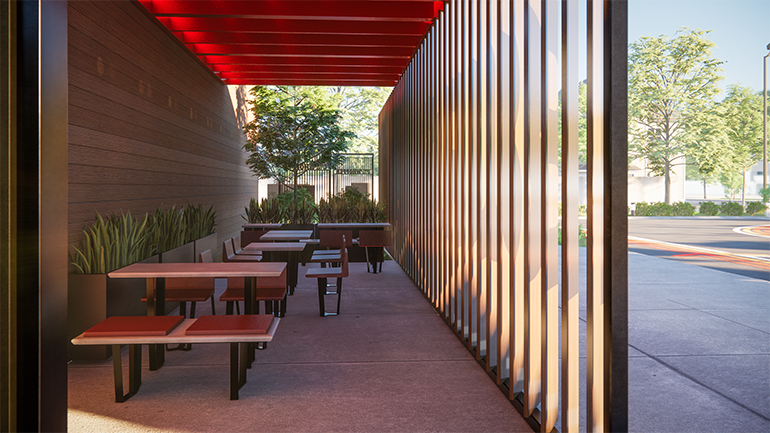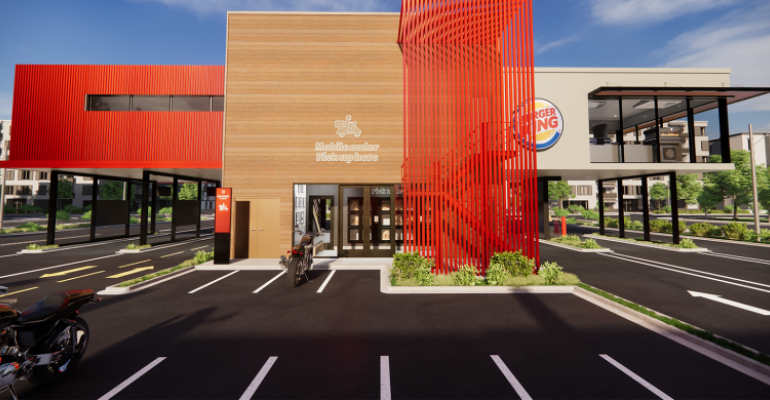Burger King today unveiled two new “Restaurant of Tomorrow” designs that will guide the brand’s future development and tap into consumer changes wrought by the coronavirus pandemic.
The No. 2 burger brand, a division of Toronto-based Restaurants Brands International Inc., expects the first domestic version of the two new looks to be built in Miami in 2021, but it is developing aspects of the new COVID-19 Age design in some existing restaurants.
The prototypes provide as many as three drive-thru lanes, spots for covered drive-in areas, curbside pickup, lockers for mobile and delivery orders, walkup options, outdoor dining areas and even, in the “Next Level” design, a second story with kitchens and other operations on a second floor.
“To do something so disruptive as this design, it needed a very strong collaboration between teams,” said Rapha Abreu, RBI’s global head of design, said in a phone interview Wednesday.
Abreu said the design team joined forces with teams from Restaurant Brands’ technology, operations and food innovation disciplines.
“The ultimate goal was to design a seamless guest experience where digital and physical come together for the best experience,” Abreu said.
In addition to plans for Miami, the new designs will be built in Latin American and Caribbean locations, a spokesperson said.
Abreu said the new design reflects investments in technology that RBI had been making even before the pandemic.
“We’ve been building strong teams internally,” he said, which has produced innovations in the RBI brands’ smartphone applications. RBI also owns the Popeyes Louisiana Kitchen and Tim Hortons brands.
“The integration of the technology and design capabilities really culminates in these new designs,” Abreu said. “They put our guests at the core of the experience.”

Outdoor seating will be only one option available to hungry Burger King customers.
Among the innovations:
• Drive-Ins. Guests can park their cars in the drive-in area under solar powered canopies, place their orders through the BK App by scanning a quick response, or QR, code at their parking spot, and have food quickly delivered to their automobiles.
• Curbside Delivery. Advance orders placed through the mobile app will have dedicated parking spots for curbside delivery. Guests will be able to notify the restaurant team member upon arrival via the app as instructed on the parking signs.
• Pickup Lockers. Mobile and delivery orders can also be picked up from coded food lockers facing the exterior of the restaurant. The food is delivered directly from the kitchen to the pickup lockers.
• On-Premise Dining. One design option replaces the traditional indoor dining room with a shaded patio featuring outdoor seating for guests.
• Drive-Thru. A double or triple drive-thru features digital menu boards and merchandising. “The multi-lane ordering and pick-up expedites the process, while a living wall frames the guest’s view into the kitchen interior, featuring the iconic Burger King broiler,” the company said.
• Walk-Up Window. An external window on the glass facade can be an alternative ordering point for takeout.
• Suspended Kitchen and Dining Room. The “Next Level’ design option features a suspended kitchen and dining room above the drive-thru lanes configured to reduce the building footprint, which the company said would be attractive in urban driving cities.
In the “Next Level” design, orders are delivered to drive-thru guests from the suspended kitchen by a conveyor belt system, and each lane has its own pick-up spot. The design option also features a triple drive-thru with a dedicated lane for delivery drivers.
“The design of this restaurant allows a 100% touchless experience,” the company said.
“In March, our in-house design and tech team accelerated new restaurant design plans and pushed the limits of what a Burger King restaurant could be,” said Josh Kobza, RBI’s chief operating officer, said in a statement.
“We took into consideration how consumer behaviors are changing and [how] our guests will want to interact with our restaurants,” Kobza said.
Burger King charted the evolution of the consumer during the coronavirus pandemic, Abreu added, and the design team identified the frictions in the experience and created solutions.
Chiefly among those, he said, were dedicated mobile-order curbside pickup areas, a walk-up order area, exterior dining space and sustainable design elements.
For the second quarter ended June 30, Restaurant Brands’ net income fell 36.2% to $164 million, or 35 cents a share, from $257 million, or 55 cents a share, in the same period a year ago. Revenues declined 25.1% to $1.05 billion from $1.4 billion in the same quarter last year.
Restaurant Brands International has more than 27,000 restaurants in more than 100 countries and U.S. territories.
Contact Ron Ruggless at [email protected]
Follow him on Twitter: @RonRuggless





